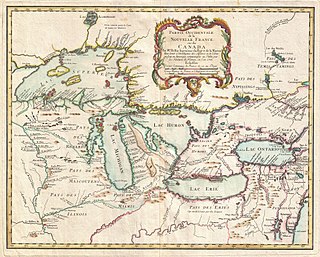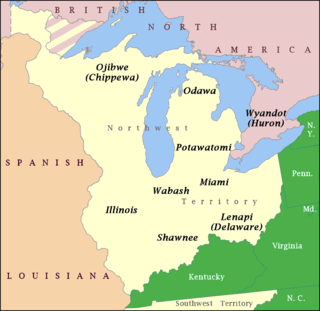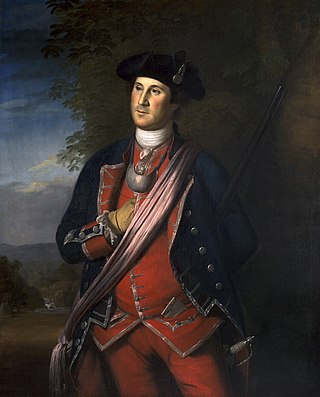
The French and Indian War (1754–1763) was a theater of the Seven Years' War, which pitted the North American colonies of the British Empire against those of the French, each side being supported by various Native American tribes. At the start of the war, the French colonies had a population of roughly 60,000 settlers, compared with 2 million in the British colonies. The outnumbered French particularly depended on their native allies.

Acadia was a colony of New France in northeastern North America which included parts of what are now the Maritime provinces, the Gaspé Peninsula and Maine to the Kennebec River.

King William's War was the North American theater of the Nine Years' War (1688–1697), also known as the War of the Grand Alliance or the War of the League of Augsburg. It was the first of six colonial wars fought between New France and New England along with their respective Native allies before France ceded its remaining mainland territories in North America east of the Mississippi River in 1763.

The Maratha Confederacy, also referred to as the Maratha Empire was an early modern polity in the Indian subcontinent comprising the realms of the Peshwa and four major independent Maratha states who were often subordinate to the former. It was formed in 1674 with the coronation of Shivaji of the House of Bhonsle as the Chhatrapati of the Marathas. The Maratha realm was recognised by Bahadur Shah I, the Mughal emperor, as a tributary state in 1707 after a prolonged rebellion. The Marathas continued to recognise the emperor as their nominal suzerain similar to other contemporary Indian entities.

The Beaver Wars, also known as the Iroquois Wars or the French and Iroquois Wars were a series of conflicts fought intermittently during the 17th century in North America throughout the Saint Lawrence River valley in Canada and the Great Lakes region which pitted the Iroquois against the Hurons, northern Algonquians and their French allies. As a result of this conflict, the Iroquois destroyed several confederacies and tribes through warfare: the Hurons or Wendat, Erie, Neutral, Wenro, Petun, Susquehannock, Mohican and northern Algonquins whom they defeated and dispersed, some fleeing to neighbouring peoples and others assimilated, routed, or killed.

Pontiac's War was launched in 1763 by a loose confederation of Native Americans who were dissatisfied with British rule in the Great Lakes region following the French and Indian War (1754–1763). Warriors from numerous nations joined in an effort to drive British soldiers and settlers out of the region. The war is named after Odawa leader Pontiac, the most prominent of many indigenous leaders in the conflict.

Dummer's War (1722–1725) was a series of battles between the New England Colonies and the Wabanaki Confederacy, who were allied with New France. The eastern theater of the war was located primarily along the border between New England and Acadia in Maine, as well as in Nova Scotia; the western theater was located in northern Massachusetts and Vermont at the border between Canada and New England. During this time, Maine and Vermont were part of Massachusetts.

The Sixty Years' War was a military struggle for control of the North American Great Lakes region, including Lake Champlain and Lake George, encompassing a number of wars over multiple generations. The conflicts involved the British Empire, the French colonial empire, the United States, and the Indigenous peoples of the Americas. The term Sixty Years' War is used by academic historians to provide a framework for viewing this era as a whole, rather than as isolated events.

Charles Jacques Huault de Montmagny was governor of New France from 1636 to 1648. He was the first person to bear the title of Governor of New France and succeeded Samuel de Champlain, who governed the colony as Lieutenant General of New France. Montmagny was able to negotiate a peace treaty with the Iroquois at Trois-Rivières in 1645.

A subsidiary alliance, in South Asian history, was a tributary alliance between an Indian state and a European East India Company.
Winamac was the name of a number of Potawatomi leaders and warriors beginning in the late 17th century. The name derives from a man named Wilamet, a Native American from an eastern tribe who in 1681 was appointed to serve as a liaison between New France and the natives of the Lake Michigan region. Wilamet was adopted by the Potawatomis, and his name, which meant "Catfish" in his native Eastern Algonquian language, was soon transformed into "Winamac", which means the same thing in the Potawatomi language. The Potawatomi version of the name has been spelled in a variety of ways, including Winnemac, Winamek, and Winnemeg.

The Northwestern Confederacy, or Northwestern Indian Confederacy, was a loose confederacy of Native Americans in the Great Lakes region of the United States created after the American Revolutionary War. Formally, the confederacy referred to itself as the United Indian Nations, at their Confederate Council. It was known infrequently as the Miami Confederacy since many contemporaneous federal officials overestimated the influence and numerical strength of the Miami tribes based on the size of their principal city, Kekionga.
The Fox Wars were two conflicts between the French and the Fox people that lived in the Great Lakes region from 1712 to 1733. These territories are known today as the states of Michigan and Wisconsin in the United States. The Wars exemplified colonial warfare in the transitional space of New France, occurring within the complex system of alliances and enmities with native peoples and colonial plans for expansion.

The Wabanaki Confederacy is a North American First Nations and Native American confederation of five principal Eastern Algonquian nations: the Abenaki of St. Francis, Mi'kmaq, Maleceet, Passamaquoddy (Peskotomahkati) and Penobscot.

The Seven Years' War (1756–1763) was a global conflict involving most of the European great powers, fought primarily in Europe and the Americas. One of the opposing alliances was led by Great Britain and Prussia. The other alliance was led by France, backed by Spain, Saxony, Sweden, and Russia. Related conflicts include the 1754 to 1763 French and Indian War, and 1762 to 1763 Anglo-Spanish War.

Tecumseh's confederacy was a confederation of Native Americans in the Great Lakes region of North America which formed during the early 19th century around the teaching of Shawnee leader Tenskwatawa. The confederation grew over several years and came to include several thousand Native American warriors. Shawnee leader Tecumseh, the brother of Tenskwatawa, became the leader of the confederation as early as 1808. Together, they worked to unite the various tribes against colonizers from the United States who had been crossing the Appalachian Mountains and occupying their traditional homelands.
Diplomacy was a central component of the American Revolutionary War and broader American Revolution. In the years leading up to the outbreak of military hostilities in 1775, the Thirteen Colonies and Great Britain had sought a peaceful diplomatic solution within the British political system. Once fighting began, diplomacy in the American Revolutionary War became critical to each faction for both strategic and ideological reasons. The American colonists sought forward aid and support to counter Great Britain's overwhelming strategic, military, and manpower advantages as well as to garner political legitimacy through international recognition; Great Britain sought to contain these diplomatic overtures while also leveraging its foreign relations with Native American tribes and German states. The American Declaration of Independence in July 1776 escalated these developments as the erstwhile sovereign United States evolved an independent foreign policy. Diplomacy would prove critical to shaping the trajectory and outcome of the war, as Americans relations with several foreign powers—particularly France and Spain—allowed access to decisive war material, funds, and troops while at the same time isolating Britain globally and spreading thin its military.

Colonial American military history is the military record of the Thirteen Colonies from their founding to the American Revolution in 1775.

Kondiaronk, known as Le Rat, was Chief of the Native American Wendat people at Michilimackinac in New France. As a result of an Iroquois attack and dispersal of the Hurons in 1649, the latter settled in Michilimackinac. The Michilimackinac area is the strait between Lakes Huron and Michigan in the present-day United States.
The Protocol of St. Petersburg was an 1826 Anglo-Russian agreement for the settlement of the Greek War of Independence.














